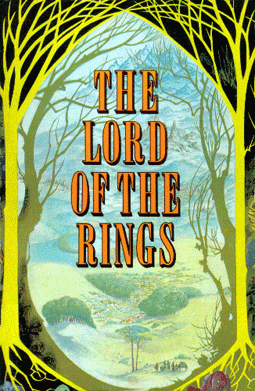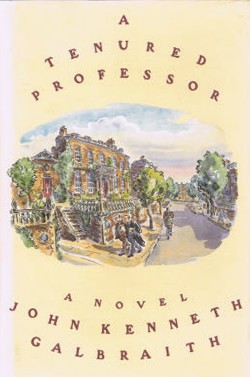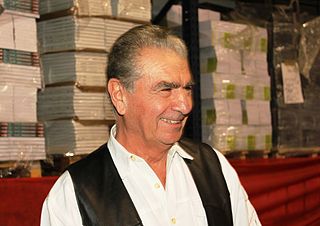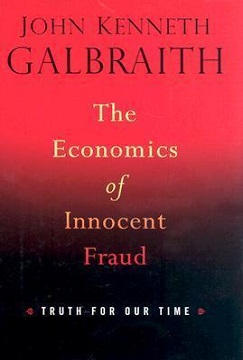
The Lord of the Rings is an epic high fantasy novel by the English author and scholar J. R. R. Tolkien. Set in Middle-earth, the story began as a sequel to Tolkien's 1937 children's book The Hobbit, but eventually developed into a much larger work. Written in stages between 1937 and 1949, The Lord of the Rings is one of the best-selling books ever written, with over 150 million copies sold.
The Nazgûl, introduced as Black Riders and also called Ringwraiths, Dark Riders, the Nine Riders, or simply the Nine, are fictional characters in J. R. R. Tolkien's Middle-earth. They were nine Men who had succumbed to Sauron's power through wearing Rings of Power, which gave them immortality but reduced them to invisible wraiths, servants bound to the power of the One Ring and completely under Sauron's control.
The "Ainulindalë" is the creation account in J. R. R. Tolkien's legendarium, published posthumously as the first part of The Silmarillion in 1977. The "Ainulindalë" sets out a central part of the cosmology of Tolkien's legendarium, telling how the Ainur, a class of angelic beings, perform a great music prefiguring the creation of the material universe, Eä, including Middle-Earth. The creator Eru Ilúvatar introduces the theme of the sentient races of Elves and Men, not anticipated by the Ainur, and gives physical being to the prefigured universe. Some of the Ainur decide to enter the physical world to prepare for their arrival, becoming the Valar and Maiar.

Fëanor is a fictional character in J. R. R. Tolkien's The Silmarillion. He creates the Tengwar script, the palantír seeing-stones, and the three Silmarils, the skilfully-forged jewels that give the book their name and theme, triggering division and destruction. He is the eldest son of Finwë, the King of the Noldor Elves, and his first wife Míriel.

John Kenneth Galbraith, also known as Ken Galbraith, was a Canadian American economist, diplomat, public official, and intellectual. His books on economic topics were bestsellers from the 1950s through the 2000s. As an economist, he leaned toward post-Keynesian economics from an institutionalist perspective.

In social science and politics, power is the social production of an effect that determines the capacities, actions, beliefs, or conduct of actors. Power does not exclusively refer to the threat or use of force (coercion) by one actor against another, but may also be exerted through diffuse means. Power may also take structural forms, as it orders actors in relation to one another, and discursive forms, as categories and language may lend legitimacy to some behaviors and groups over others.

A Tenured Professor (1990) is a satirical novel by Canadian-American economist and Harvard professor emeritus John Kenneth Galbraith about a liberal university teacher who sets out to change American society by making money and then using it for the public good. Set at Harvard mainly during the Reagan administration, the plot and all the characters that appear in the story are entirely fictitious.
Scott O'Dell was an American writer of 26 novels for young people, along with three novels for adults and four nonfiction books. He wrote historical fiction, primarily, including several children's novels about historical California and Mexico. For his contribution as a children's writer he received the biennial, international Hans Christian Andersen Award in 1972, the highest recognition available to creators of children's books. He received The University of Southern Mississippi Medallion in 1976 and the Catholic Libraries Association Regina Medal in 1978.

Anti-authoritarianism is opposition to authoritarianism, which is defined as "a form of social organisation characterised by submission to authority", "favoring complete obedience or subjection to authority as opposed to individual freedom" and to authoritarian government. Anti-authoritarians usually believe in full equality before the law and strong civil liberties. Sometimes the term is used interchangeably with anarchism, an ideology which entails opposing authority or hierarchical organization in the conduct of human relations, including the state system.

"Namárië" is a poem by J. R. R. Tolkien written in one of his constructed languages, Quenya, and published in The Lord of the Rings. It is subtitled "Galadriel's Lament in Lórien", which in Quenya is Altariello nainië Lóriendessë. The poem appears, too, in a book of musical settings by Donald Swann of songs from Middle-earth, The Road Goes Ever On; the Gregorian plainsong-like melody was hummed to Swann by Tolkien. The poem is the longest Quenya text in The Lord of the Rings and also one of the longest continuous texts in Quenya that Tolkien ever wrote. An English translation is provided in the book.

Technostructure is the group of technicians, analysts within an organisation with considerable influence and control on its economy. The term was coined by the economist John Kenneth Galbraith in The New Industrial State (1967). It usually refers to managerial capitalism where the managers and other company leading administrators, scientists, or lawyers retain more power and influence than the shareholders in the decisional and directional process.

Michael Bar-Zohar is an Israeli historian, novelist and politician. He was a member of the Knesset on behalf of the Alignment and Labor Party in the 1980s and early 1990s.
Magic in Middle-earth is the use of supernatural power in J. R. R. Tolkien's fictional Middle-earth. Tolkien distinguishes ordinary magic from witchcraft, the latter always deceptive, stating that either type could be used for good or evil.
A Elbereth Gilthoniel is an Elvish hymn to Varda in J. R. R. Tolkien's The Lord of the Rings. It is the longest piece of Sindarin in The Lord of the Rings. It is not translated in the main text where it is first presented.

The Culture of Contentment is an essay by economist John K. Galbraith, analyzing the situation of the Western industrial world, which was first published in 1992 by Houghton Mifflin Company.
Zero stroke or cipher stroke was an alleged mental disorder, reportedly diagnosed by physicians in Germany during the hyperinflation in the Weimar Republic (1921–24). The disorder was primarily characterized by the desire of patients to write endless rows of zeros, which are also referred to as ciphers.

The Economics of Innocent Fraud: Truth for Our Time was Harvard economist John Kenneth Galbraith's final book, published by Houghton Mifflin in 2004. It is a 62-page essay that recapitulates themes—such as the dominance of corporate power in the public sector and the role of advertising in shaping consumer demand—found in earlier works.
The geography of Middle-earth encompasses the physical, political, and moral geography of J. R. R. Tolkien's fictional world of Middle-earth, strictly a continent on the planet of Arda but widely taken to mean the physical world, and Eä, all of creation, as well as all of his writings about it. Arda was created as a flat world, incorporating a Western continent, Aman, which became the home of the godlike Valar, as well as Middle-earth. At the end of the First Age, the Western part of Middle-earth, Beleriand, was drowned in the War of Wrath. In the Second Age, a large island, Númenor, was created in the Great Sea, Belegaer, between Aman and Middle-earth; it was destroyed in a cataclysm near the end of the Second Age, in which Arda was remade as a spherical world, and Aman was removed so that Men could not reach it.

The plants in Middle-earth, the fictional world devised by J. R. R. Tolkien, are a mixture of real plant species with fictional ones. Middle-earth was intended to represent the real world in an imagined past, and in many respects its natural history is realistic.












